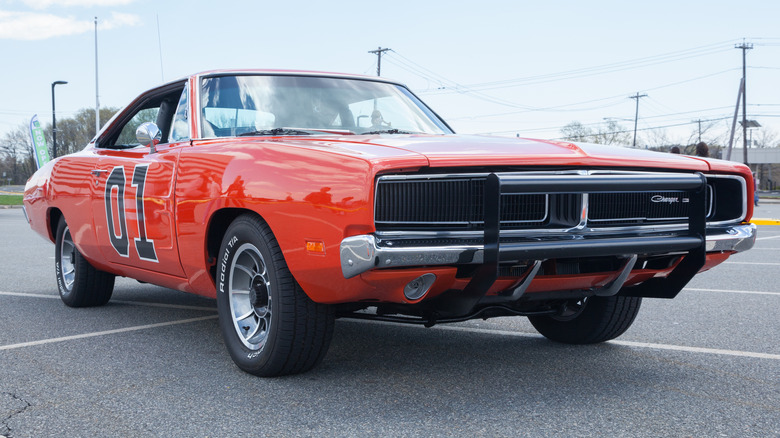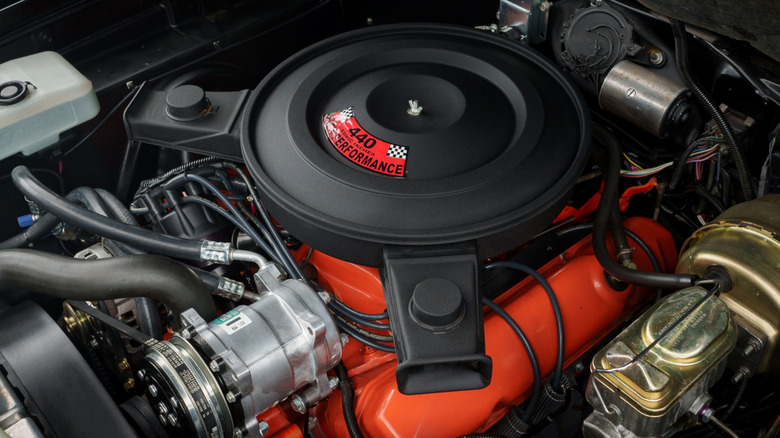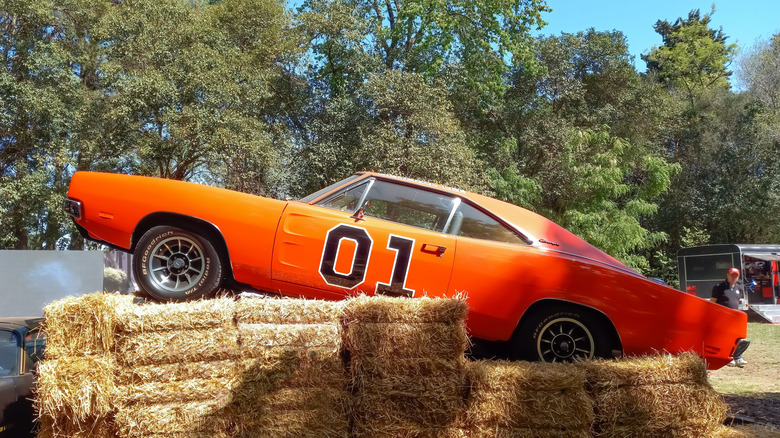What Kind Of Car Was The General Lee, And Which Engine Was Under The Hood?
Throughout the history of television and film, cars have played an important role. While the majority of silver screen featured cars are quickly forgotten, a handful of them become just as famous as the film stars that pilot them. Just think about the Aston Martin DB5 of the "James Bond" franchise, or Steve McQueen's iconic "Bullitt" Mustang.
Another legend of the screen is the General Lee — a bright orange B-body Dodge Charger which featured heavily throughout "The Dukes of Hazzard". The show itself was a huge success, running from 1979 through to 1985. At the time, the American muscle car was very much in hiding, thanks largely to the oil crisis of 1973, so it makes sense the production company went back in time and sourced a classic muscle car, as this would've had much more grunt than contemporary offerings.
Throughout the show, hundreds of Dodge Charger models were used – both 1968 and 1969 models – with the show getting through a rough average of one car per episode. This was predominantly due to the wild stunts featured within "The Dukes of Hazzard," which would render many a Dodge quickly unfit for purpose.
For scenes filmed with Bo and Luke Duke at the wheel, the Charger would be powered by a 375 horsepower 440ci V8, but other engines were used as well. Some would be powered by a smaller 383ci V8 motor, while at least one 318ci V8-powered model was used, as it would be lighter, and therefore ideal for a daring two-wheel stunt.
General Lee was far from a standard Dodge Charger
There has been no shortage of General Lee replicas over the years, although if making a faithful replica is your goal, then there are a plethora of details you'll need to get spot on. Firstly, the color in question is Hemi Orange — even casual fans will likely be able to notice if this famous hue is anything other than perfect. Next, every General Lee wore a confederate flag on the roof, '01' numbering on the doors, and very early examples had crossed flags just behind the rear window, too. Furthermore, on these earliest of cars, chrome trim can be seen at the base of the C-pillar. This was because the cars used were originally vinyl roof models, but the vinyl itself had been removed.
Other changes to the Chargers used included a racing carburetor and glasspack muffler — modifications designed to ensure General Lee both went and sounded as good as it looked. Visual modifications included a roll bar for the driver and welded shut doors, so you'd better get used to sliding in through the window. A set of 10-spoke American Racing Vector SE alloy wheels will finish the look.
Versions of the General Lee which were designed for stunt use varied from the typical examples, as not only would they sport a full roll cage, but the car would also be packed full of sand or concrete. This was to balance out the weight distribution, so that the car would land neatly upon impact after a daring jump.
Jumping into General Lee costs an awful lot more in 2025
At the time of filming, a 1969 Dodge Charger was between 10 and 16 years old, which meant getting hold of one was pretty easy, and very affordable. They were just used cars, albeit interesting and fast ones.
Fast-forward to 2025, however, and oh how the tables have turned. Classic car prices can appreciate in value over time, and this famous Dodge is definitely a textbook example. The Charger is now remembered as one of the most iconic nameplates from the muscle car era, and because of that, fans scramble to get their hands on one, regardless of the condition.
According to Hagerty, the very best examples of 440-equipped '69 Charger R/T models fetch $118,000, while even those which need work to bring up to scratch will command between $44,200 and $60,200. The good news is, Hagerty's data also shows that prices are down roughly 8% across the board from last year, so your General Lee dream is actually getting a touch more affordable as classic car prices level out.


